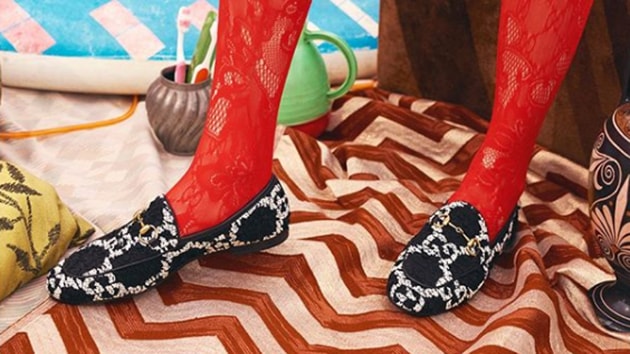Do Your Gucci Loafers Make You Feel Ashamed?
Yet no matter how much attention the fashion industry pays to the planet, this business is still about getting people to spend money on stuff they could live without.
“Flygskam” (or flight shame) has made some people too embarrassed to fly because of the damage to the planet. Might fashion be the next business to suffer as consumers put on their environmental hair shirts?

Bernard Arnault, chairman of luxury behemoth LVMH Moet Hennessy Louis Vuitton SE, has criticised the 16-year-old climate activist Greta Thunberg as being “demoralising for young people.” She’s probably a bit of a downer for him too.
Arnault’s business depends on shoppers, especially young ones, buying lots of unnecessary stuff, from Christian Dior saddlebags to expensive lipsticks from the pop star Rihanna’s Fenty range. Fretting about an impending environmental catastrophe, and worrying that your purchases are contributing to it, is hardly conducive to a spot of retail therapy.
The clothing and footwear industries (of which luxury is only a part) contribute about 8% of global C02 emissions, according to Quantis, an environmental consultancy. The Ellen MacArthur foundation, a non-profit organisation, estimates that the textiles business generated more greenhouse gas emissions in 2015 than all international flights and shipping combined. There’s plenty here to infuriate Thunberg.
Reliable data on the luxury industry’s environmental performance isn’t easy to come by, but one group (made up of Global Fashion Agenda, an industry forum, the Sustainable Apparel Coalition and the Boston Consulting Group) has had a go at creating at a scorecard. This “Pulse Score” is based on elements such as the ecological smartness of product design, raw material use and manufacturing processes. Getting 100 would be perfection on sustainability; nobody comes close to that.
Overall, fashion had a pretty underwhelming score of 42 out of 100, although the big luxury companies scored a slightly more respectable 54. While this isn’t exactly cause to celebrate, it does show that the financial clout of LVMH — and its big peers such as Gucci-owning Kering SA and Switzerland’s Compagnie Financiere Richemont SA (home to Cartier) — might be an advantage when it comes to trying to mitigate their impact on the planet and its resources.
Yet one can’t ignore the scale of that industry impact. The luxury goods makers have enjoyed more than three years of blockbuster growth, driven largely by Chinese shoppers, meaning they’re gobbling up more natural resources than ever. And as the chart below shows, the natural materials favoured by the fashionable elite have the worst effect on the environment (silk is a particular disaster).
None of this is helped by the wasteful practices of many shoppers, who move on quickly to the next hot design, or indeed some of the companies. Britain’s Burberry Group Plc came under justified fire last year for its now abandoned practice of destroying unsold stock to prevent it being sold off cheaply.
Kering, founded by Arnault’s great rival Francois Pinault, does at least try to be transparent about the damage it does. It publishes an environmental profit and loss account, which put the cost of its impact on the planet in 2018 at about 500 million euros ($549 million). It estimates that about three-quarters of this came from raw materials processing and production. Still, while it’s honest of them to publish these data, the harm is still being done.
LVMH has kept a lower profile, though it does perform well on one measure. Morgan Stanley analysts say that the more a luxury company does its own manufacturing, the better it performs on environmental, social and governance targets. That’s because some of the worst industry practices happen in the supply chain away from the direct control — and responsibility — of the parent.
The LVMH brands rank well on this measure, according to the Morgan Stanley research. Three of its brands (Loro Piana, Louis Vuitton and Christian Dior) do most of their own manufacturing.
As Arnault’s attack on Thunberg highlighted, there’s a reason why these companies are trying to mend their ways: younger shoppers, including Chinese ones, are demanding it. In 2018 all of the industry’s growth came from the under-40s, according to consultants at Bain & Company. Those consumers are more likely to be loyal to brands with a conscience.
Yet no matter how much attention the industry pays to the planet, this business is still about getting people to spend money on stuff they could live without. If the rich can be shamed into giving up their far-flung holidays, what does the future hold for Gucci’s diamond belt?
(This story has been published from a wire agency feed without modifications to the text.)
Follow more stories on Facebook and Twitter
Catch your daily dose of Fashion, Health, Festivals, Travel, Relationship, Recipe and all the other Latest Lifestyle News on Hindustan Times Website and APPs.



